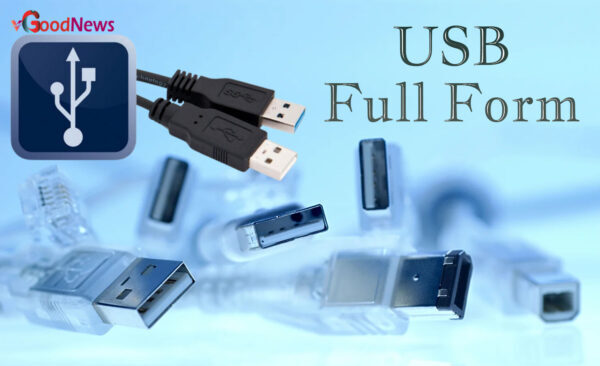Introduction: USB Full Form
USB Full Form: The Universal Serial Bus, commonly known as USB, is a standard used to facilitate connection and communication between computers and various electronic devices. It enables the transfer of data seamlessly, making it an essential component in the world of digital connectivity. This article explores the features, types, uses, and benefits of USB, highlighting its importance in modern technology.
USB Full Form: What is USB?
USB, or Universal Serial Bus, is a technology that allows for the connection and communication between computers and peripheral devices. The primary function of USB is to transfer data between devices efficiently. Connecting a USB device to a computer is straightforward—simply insert the USB device into the computer’s USB port, and it will automatically detect and begin working with the device. USB Full Form
Advantages of USB: USB Full Form
- Unified Connectivity: USB allows various devices to be connected using the same cables and connectors, simplifying the process of linking multiple peripherals to a single computer.
- Versatility: It supports a wide range of devices, including external hard drives, digital cameras, remote controls, and more.
- Power Management: USB can maintain a balance of power, especially when connected to high-capacity battery packs, ensuring efficient energy use.
- Ease of Use: Programmers can compile multiple programs using a single codebase, enhancing development efficiency.
- Reliability and Speed: USB is known for its reliability and fast data transfer rates, making it a preferred choice for many applications.
Types of USB: USB Full Form
USB comes in various types, each serving specific functions and offering different performance levels: USB Full Form
- Standard: The basic form of USB, widely used for everyday devices.
- High-Speed: Offers faster data transfer rates for devices requiring higher bandwidth.
- Extended: Provides additional features and capabilities beyond standard USB.
- Wireless: Enables wireless connectivity between devices, eliminating the need for physical cables.
- Low Power: Designed for devices with minimal power requirements, such as certain portable electronics.
- Memory Stick: A type of USB used for storage and data transfer.
- Display Link: Allows for the connection of display devices, such as monitors and projectors.
- Screen Capture: Used for capturing and recording screen activity.
- RAID: Supports data redundancy and performance improvement through RAID configurations.
- HDMI Display: Combines USB and HDMI capabilities for high-definition display connectivity.
Each type of USB has specific applications and technical components that define its functionality and compatibility with various devices. USB Full Form
USB Full Form: Uses of USB
USB is used in numerous applications, making it an integral part of modern technology. Some common uses include: USB Full Form
- Charging Devices: USB ports are commonly used to charge portable electronic devices like phones, MP3 players, and digital cameras.
- Data Transfer: Enables the transfer of data between devices, such as from a digital camera to a computer.
- Peripheral Connectivity: Connects peripherals like keyboards, mice, printers, and external hard drives to computers.
- Communication and Power Supply: USB devices can provide both data communication and power supply, making them versatile and efficient.
- Conversion and Adaptation: USB to serial converters allow for the connection of older devices with serial ports to modern computers with USB ports.
USB Full Form: Benefits of USB
- Single High-Speed Port: In computers, a single USB port can connect multiple peripherals, reducing the need for numerous cables.
- Ease of Access: USB ports are typically located on the back or sides of computers and mobile devices, making them easily accessible.
- Plug and Play: Connecting a USB device is as simple as plugging it into the port, with the computer automatically recognizing and configuring the device.
- Reset and Configuration: USB devices can be reset to factory default settings by holding specific buttons, simplifying troubleshooting and configuration.
Disadvantages of USB
Despite its many advantages, USB technology has some limitations: USB Full Form
- Complex Identification: Differentiating between various USB types can be challenging due to similar physical connectors and numbering systems.
- Multiple Controllers: New USB devices may have multiple controller numbers, complicating the connection process.
- Evolving Standards: USB standards change rapidly, requiring frequent updates and adaptations for compatibility with new devices.
Conclusion
USB technology has revolutionized the way we connect and communicate between devices. Its versatility, reliability, and ease of use make it an essential component of modern computing and electronic devices. Whether for data transfer, device charging, or peripheral connectivity, USB (USB Full Form) remains a vital tool in the digital age. As technology continues to evolve, USB standards will adapt, ensuring continued compatibility and enhanced performance.
FAQs about USB Full Form
What is the full form of USB?
The full form of USB is Universal Serial Bus.
What are the different types of USB?
There are several types of USB, including Standard, High-Speed, Extended, Wireless, Low Power, Memory Stick, Display Link, Screen Capture, RAID, and HDMI Display.
How do I connect a USB device to my computer?
To connect a USB device, insert the USB plug into your computer’s USB port. The computer will detect the device automatically, and you can start using it immediately.
What are the advantages of using USB?
USB offers unified connectivity, versatility, efficient power management, ease of use, reliability, and fast data transfer rates, making it a preferred choice for many applications.
Can USB devices be reset to factory default settings?
Yes, USB devices can be reset to factory default settings by pressing and holding specific buttons designed for this purpose.

